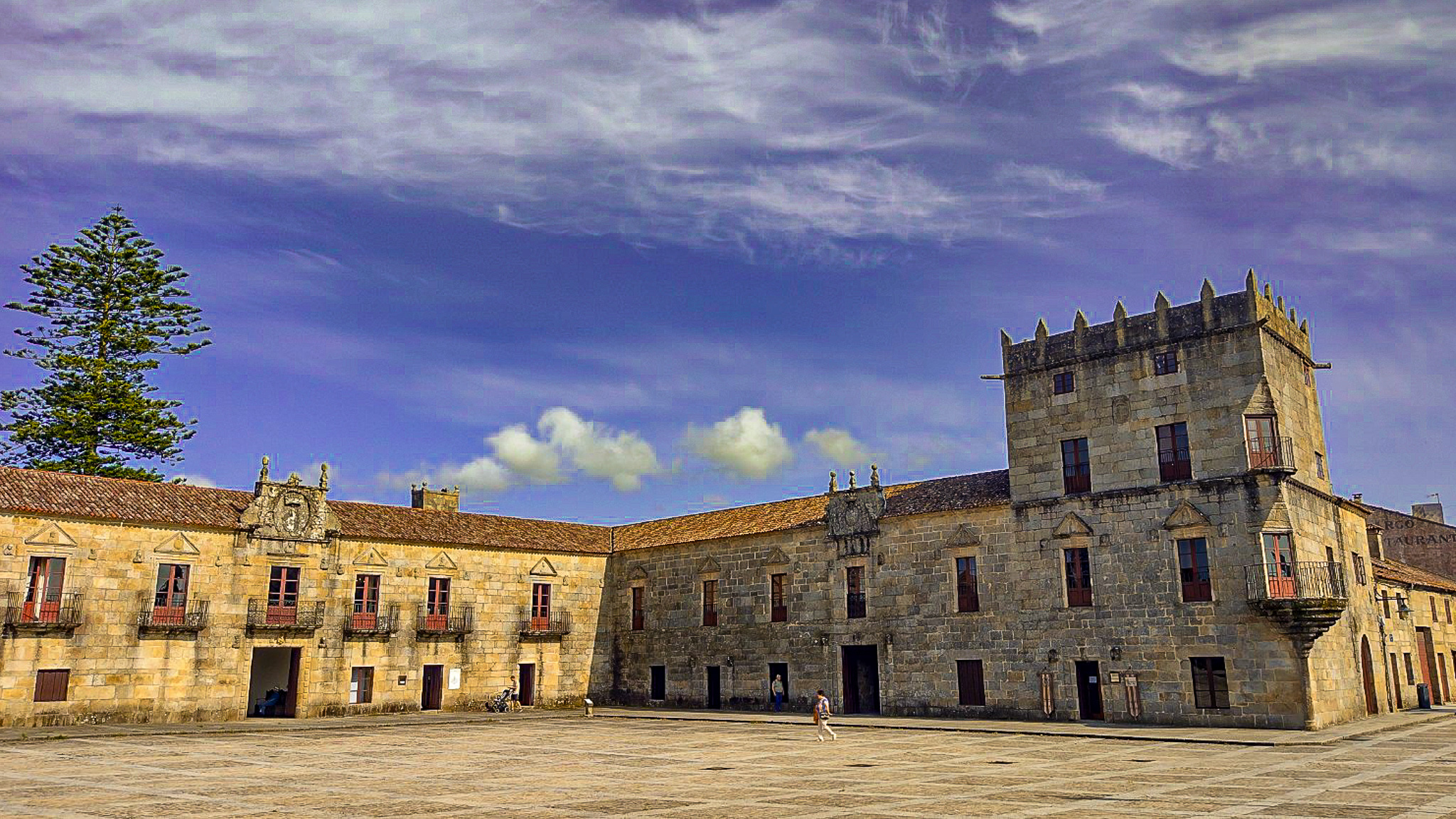Pretty Cambados on the Ria de Arousa is the capital of the Albarino winemaking denomination.
Styling itself as a fishing village, really its an elegant coastal town renowned for its historical centre and the ruins of a sea wall and watch tower built to deter Norman invaders in the 11th century.
It’s full of history, culture, traditions and noble heritage, along with gastronomy and wines – and of course, you can’t escape the plentiful gift shops selling the local produce to groups of tourists who visit in large numbers every day.

Our visit started at possibly Spain’s most efficiently run parking site for ‘autocaravanes’.
Booking ahead online (really?) and arriving at a barrier with number plate recognition (what, really??) we parked up on a numbered and flat, level grassy pitch having got fresh water onboard at the hyperclean service area. We were even surrounded by the vines of the famous local wine.
This was a level above any city camperstop or aire we’ve experienced in 14 years of travelling across Europe!

Simon got chatting to the owner, a commercial airline pilot and motorhomer, who created the site as ‘a lockdown project’. He flies long-haul for three or four days a week, then returns to live on the site and maintain it.
Walking along boardwalk through the neighbouring conservation area we approached Cambados from its beach. I was struck by the modernist streetlights along the Passeo Maritimo which had been upgraded to LED filament bulbs.
Partly because streetlights were featuring heavily in my work and partly because they were such a unique design, I started looking out for other luz de la calle.
We enjoyed meandering past the bodegas and wine merchants housed smartly in the historical centre. The Plaza and Palacio de Fefinans, now a high end parador, crowns the top of the town next to the 16th century Iglesia de San Benito.
Simon chuckled at its English translation to ‘Church of Saint Well Done’. It was hot, 30 degrees in the evening shade so we joined a boisterous tour group in a shady square for a tasting of the local wine. The teenage waiters were non plussed as people shouted across their orders for wine, coffee and ice creams. Eventually we got to taste a small glass of the chilled, light and refreshing Albarino and toast a pretty town and terrific Area de Autocaravanes Cambados.
Inland on a tributary of the Rio Ulla, Padron was a mighty seaport until it silted up. Today the river is a narrow stream banked by long grasses and passing under stone bridges on its way to empty into the Rio de Arousa.
Standing on a flagstone walkway under the welcome shade of an avenue of heavy-leafed silver plane trees, we were walking on the waters of Padron’s earlier, classical, harbour.
We pondered how time and tide shapes the fortunes of people and places and that sometimes elemental change cannot be defeated. It was sobering to consider this in the light of 21st century climate change.

The nearby church of Santiago was humming with pilgrims arriving on the Portuguese Route of the Camino de Santiago de Compostela.
There are seven routes in total established by the Catholic Church over several hundred years. There’s also an optional ‘spiritual diversion’, which winds along the Ria de Arousa, including through Cambados.
Padron is a highlight as it is thought to be the place where the body of the Apostle James was brought from Palestine for burial in Galicia. In the church of his name, the mooring stone of the boat the relics were transported on is fixed underneath the alter.

Padron means mooring stone. Originally a Roman altarpiece it still has an inscription NO ORI ESES D S P which translates as ‘To Neptune with the contribution of the Irienses’.
It is a tradition to crouch at the stone and toss a few copper cents to land on it for a wish. We didn’t realise this until it was almost our turn amid a gaggle of excitedly chattering Portuguese pilgrims.
A noisy Dutch chap decided he needed a selfie so took several attempts throwing his coins backward and rolling around on the alter carpet trying to frame himself for the shot. Finally taken he dashed off, shouting after his group of walkers.

An American woman with walking poles and in pink lycra sports gear jostled for a photo and then asked me if I knew what was going on. It was baffling to think she didn’t know why or what she was looking at.
Having a Catholic childhood, I felt uncomfortable even being at the altar, never mind crouching underneath it with the intent to make a wish. I was very aware of a young man kneeling in the front pew and looking aghast at the behaviour. It was with some relief I got up having wished we might see Santiago de Compostela and have a good visit the next day.

















